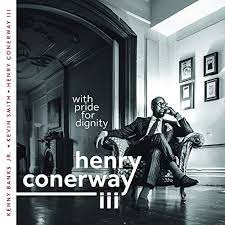
Review: Henry Conerway III | With Pride For Dignity
Smile is what you do when hearing a compelling sound. That is exactly what I did when the first notes of the opening track filled the room. It takes a bassist to arrange a bassist’s composition and make it fresh.
Hailing from the Motor City, Henry Conerway honed his skills in the hallowed halls and practice rooms of Morehouse College as well as the stages of Atlanta clubs. This adroit but ever humble practitioner enlists two of the city’s finest jazz purveyors to accompany him on this sojourn through time – pianist Kenny Banks Jr. and bassist Kevin Smith. His musical acumen is steeped in the history and tradition of jazz, making his choice of compositions from the pantheon not so startling as he ventures through three generations of jazz masters and contemporaries – Ray Brown, Phineas Newborn, Duke Ellington, Jimmy Heath, Marcus Printup and Kenny Banks, Jr..
It is a well known fact that one should not take on a classic if one can bring nothing new to the canon and Ray Brown’s Slippery is one such composition. Conjuring up a myriad of thoughts as to what he may have been thinking when he composed this song, the trio puts its own spin while taking each listener on a personal sojourn with a new arrangement by Smith, raising the tempo ever so slightly to give it a fresh sound. The title track, With Pride For Dignity, composed by Banks begins quietly with a piano solo, that immediately put me in the revered mood of Danny Boy then quickly sent me to the equally reverent first line of New Orleans before stealthily moves through a series of jazz periods, giving one a sense of the pride and dignity of this recording session. Newborn’s composition Sugar Ray elicits thoughts of the great pugilist named Robinson, illustrating the grace and style with which he fought. Of course, with later generation the song could have meaning for Leonard or even Richard Pryor’s role in Harlem NIghts depending on perspective. His choice of the 1940 Ellington composition Cottontail, written for orchestra, deftly translates the emotion into a trio setting with all the tempo and panache a big band would express. Smith quickly walks the bass as he paces the music leading into the brush work of Conerway. I could have been in the Savoy Ballroom testifying to this performance as Jitterbuggers or Lindyhoppers paraded the floor.
Hopscotch by composer and irrepressible trumpeter Printup is not the stuff of school girls tossing stones and jumping in chalk-lined squares but exhibits a similar humor of adults reminiscing those sidewalks as the trio swings this one. Heath’s Gingerbread Boy proves that jazz is never easy and placing it among such revered company is the epitome of this talented threesome true to their character. Banks follows this with another of his compositions The Feel Goods with a short overture that leads into a hip swing that best exemplifies the best times of our lives. Conerway closes with Carvin’s Agreement, an original composition he penned to pay tribute to one of his teachers, Michael Carvin, showing us just what drums can do.
Conerway’s svelte delivery as a leader keeps him in stride with his compatriots who swing equally gentle or sassy when called upon. An inventive drummer, he carries each song with equal parts to his companions, never overshadowing the others. Having witnessed the growth of these young men over the years, they were satisfied on many an occasion to sit unnoticed in the audience while gleaning pointers from the masters, a practice few young musicians find a need to do in this day and age. Like all great musicians they also realize there is still much to learn, more growth to take place. So it is no surprise their evolution into this cohesive unit affords them the facility to ply their trade as well as they do. They are more than musicians, they are friends who can start, carry and finish each other’s musical conversation when required. However, I beseech you to not overlook the liner notes so eloquently written by esteemed saxophonist and professor Dwight Andrews. Also do not dismiss the cover photography of any album because there is always a story, one deeper that you may surmise. This photograph was decidedly taken upon Henry’s request during a visit to the home of Langston Hughes. Historic on many levels.
Much more cannot be said of this album other than this is not a quick listen to see if you like it. You will. So take note music directors and programmers, it is radio friendly. You don’t need to skip tracks without listening to each one fully. If you must skip tracks it is my hope that you have a favorite song on this project and anticipation of getting to it is unbearable to see the trio’s approach. Whatever you do, this album speaks for itself and is a testament to the volumes of knowledge these industry-respected practitioners have about the music they have given their lives to enjoy performing. This is with pride for dignity and well worth the nod from their peers and a well-deserved Grammy nomination from the Recording Academy. Listen. You will be pleased.
carl anthony | notorious jazz | november 17, 2018
Give A Gift Of Jazz ~ Share ![]()
#preserving genius
More Posts: bandleader,drums,history,instrumental,jazz,music,review

